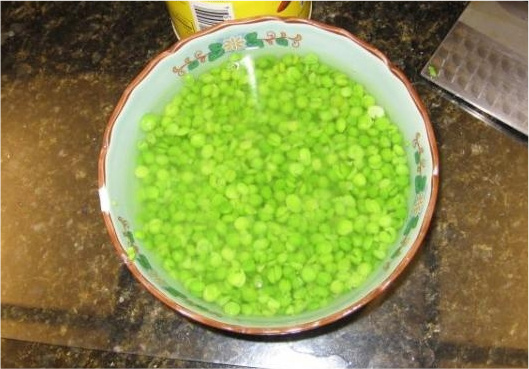Header/Title: Loricariid Vegetable Mix Recipe
Name of author: Cup
Topic: feeding
Website of origin: plecofanatics.com
The following is a pictorial guide to (hopefully) aid you in your emulation of a basic food recipe for herbivorously inclined (as there are no true obligate plant eaters in the family that I am aware of) loricariids. Natural limnivores and specialized algae eaters will certainly enjoy it, including baryancistrus, ancistrus, otocinclids, dekeyseria, chaetostoma, elongated loricariines, etc., as well as sand sifters (peudohemion, squaliforma, etc.). Even protein-affinite fish such as leporacanthicus, peckoltia, and hypancistrus should relish it to some degree--mine certainly do. It is also great, depending on the ground size of the mix, for loricariids fry, especially tricky whiptail species. Anyways, without further ado...
I started with twice par-boiled de-shelled peas. I have found very few loricariids will feed on the tough outer skin, and when included, I usually end up with an aquarium full of floating shell remnants. Not a joy to clean up, that's for sure. Broad beans (fava), I've noticed, tend to attract the attention of those fishes whose preferences lie towards meaty foods. So these can be replaced or mixed with the aforementioned if feeding, say, a pseudacanthicus tank.
Why peas? Well, firstly, they bear a fine, smooth texture perfect for fishes of all sizes, and are easily vacuumed up, catering to the interests of many specialist loricariids. Also, they bear an inherently greater amount of protein than most other sources of dietary fiber, allowing for rapid weight gain. Frankly, any other relatively soft bean should do, but, via much experimentation, I've noticed that many conventional foods of this nature (mung, reds, what have you) tend to go unnoticed.
Mash them depending on what clientèle you're working with. I prefer mine ground finely, ensuring that there is very little chunkage left--of course, some of the adjoining fibers can never be fully ground up, but do your best. This can be accomplished any which way you'd like; perhaps a food mill, or my personal preference; grinding the crap out of it with a big honkin' cleaver.

The finished product is shown below:
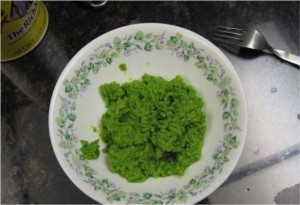
Next, we introduce a source of protein. Easily obtainable and suitable meats include small crustaceans (high in cholesterol, though to what effect that has on fish, who really knows?), shellfish (may amass organic pollutants in flesh, due to a largely sedentary, filter feeding lifestyle--also, check for sand and grit) or, my personal favorite, farmed, white meat, freshwater fish. The latter is great due to quality control of environment, grain based feeds, and low fat content. Tilapia, trout, and catfish work very well. You can always go hog wild, though, and add some flair with critters such as farmed earthworms, brine shrimp, bloodworms, mysis--I've even heard of individuals adding food grade escargo to their very similar tropheus vegetable mixes (though this is not really all that different from say, whelk or some other marine gastropod. Mince finely--enough so that it can be reasonably incorporated with the aforementioned pea mixture. Here, I chose Ecuadorian white shrimp because they were in my pantry.

Remember, this mix caters to all pallets, so adjust the pea to protein ratio accordingly. For limnivores and the like, a 4:1 sounds good. Here's a visual approximation:

Now add the shrimp (or whatever) to the pea mash. Afterwards, I like to add a good handful (palmful is more accurate) of high quality vegetable flake along with another good dose of carnivore (shrimp) flake, along with a few (here I used ten) powdered carnivore pellets. Cichlid pellets, shrimp pellets, and even goldfish food, once crushed, work well. These are added as a buffer of sorts--those essential nutrients that may fluctuate from batch to batch due to the less that scrupulous measurements taken here are supplemented by any stable, commercially prepared fish food. Vitamin additions can also help in this respect. Some recommend grinding up encapsulated supplements such as centrum, but I would be wary of this. My personal favorite method is much simpler; just add a few dashes of regular V8 (that is, vegetable juice, salt, and citric acid only).
Finally, par-boil some of your fishes' favorite soft, leafy green, and once again, attempt to mash it into a fine paste. Here, I used broad leaf spinach, but anything relatively soft is fine. This provides added dietary fiber.
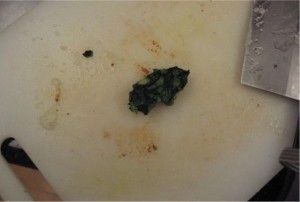
At this point, you may add enough gelatin saturated water to just cover the mixture, but I prefer it a-naturale, as the fine specks of organic matter is the effect I'm looking for here. If you fear your filtration might not be able to keep up with all the crud that will float around in the tank, by all means, go for the gelatin.
Here's a picture of some of the finished product--about 3 servings worth, depending on your fish load.
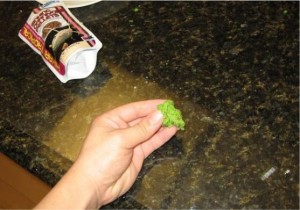
Feeding pictures and customer satisfaction:
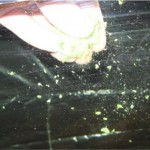
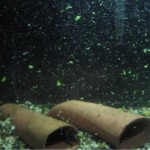
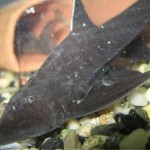
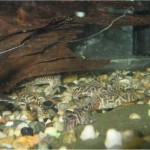
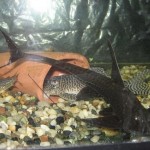
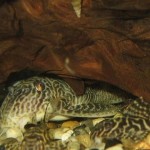
Name of author: Cup
Topic: feeding
Website of origin: plecofanatics.com
The following is a pictorial guide to (hopefully) aid you in your emulation of a basic food recipe for herbivorously inclined (as there are no true obligate plant eaters in the family that I am aware of) loricariids. Natural limnivores and specialized algae eaters will certainly enjoy it, including baryancistrus, ancistrus, otocinclids, dekeyseria, chaetostoma, elongated loricariines, etc., as well as sand sifters (peudohemion, squaliforma, etc.). Even protein-affinite fish such as leporacanthicus, peckoltia, and hypancistrus should relish it to some degree--mine certainly do. It is also great, depending on the ground size of the mix, for loricariids fry, especially tricky whiptail species. Anyways, without further ado...
I started with twice par-boiled de-shelled peas. I have found very few loricariids will feed on the tough outer skin, and when included, I usually end up with an aquarium full of floating shell remnants. Not a joy to clean up, that's for sure. Broad beans (fava), I've noticed, tend to attract the attention of those fishes whose preferences lie towards meaty foods. So these can be replaced or mixed with the aforementioned if feeding, say, a pseudacanthicus tank.
Why peas? Well, firstly, they bear a fine, smooth texture perfect for fishes of all sizes, and are easily vacuumed up, catering to the interests of many specialist loricariids. Also, they bear an inherently greater amount of protein than most other sources of dietary fiber, allowing for rapid weight gain. Frankly, any other relatively soft bean should do, but, via much experimentation, I've noticed that many conventional foods of this nature (mung, reds, what have you) tend to go unnoticed.
Mash them depending on what clientèle you're working with. I prefer mine ground finely, ensuring that there is very little chunkage left--of course, some of the adjoining fibers can never be fully ground up, but do your best. This can be accomplished any which way you'd like; perhaps a food mill, or my personal preference; grinding the crap out of it with a big honkin' cleaver.

The finished product is shown below:

Next, we introduce a source of protein. Easily obtainable and suitable meats include small crustaceans (high in cholesterol, though to what effect that has on fish, who really knows?), shellfish (may amass organic pollutants in flesh, due to a largely sedentary, filter feeding lifestyle--also, check for sand and grit) or, my personal favorite, farmed, white meat, freshwater fish. The latter is great due to quality control of environment, grain based feeds, and low fat content. Tilapia, trout, and catfish work very well. You can always go hog wild, though, and add some flair with critters such as farmed earthworms, brine shrimp, bloodworms, mysis--I've even heard of individuals adding food grade escargo to their very similar tropheus vegetable mixes (though this is not really all that different from say, whelk or some other marine gastropod. Mince finely--enough so that it can be reasonably incorporated with the aforementioned pea mixture. Here, I chose Ecuadorian white shrimp because they were in my pantry.

Remember, this mix caters to all pallets, so adjust the pea to protein ratio accordingly. For limnivores and the like, a 4:1 sounds good. Here's a visual approximation:

Now add the shrimp (or whatever) to the pea mash. Afterwards, I like to add a good handful (palmful is more accurate) of high quality vegetable flake along with another good dose of carnivore (shrimp) flake, along with a few (here I used ten) powdered carnivore pellets. Cichlid pellets, shrimp pellets, and even goldfish food, once crushed, work well. These are added as a buffer of sorts--those essential nutrients that may fluctuate from batch to batch due to the less that scrupulous measurements taken here are supplemented by any stable, commercially prepared fish food. Vitamin additions can also help in this respect. Some recommend grinding up encapsulated supplements such as centrum, but I would be wary of this. My personal favorite method is much simpler; just add a few dashes of regular V8 (that is, vegetable juice, salt, and citric acid only).
Finally, par-boil some of your fishes' favorite soft, leafy green, and once again, attempt to mash it into a fine paste. Here, I used broad leaf spinach, but anything relatively soft is fine. This provides added dietary fiber.

At this point, you may add enough gelatin saturated water to just cover the mixture, but I prefer it a-naturale, as the fine specks of organic matter is the effect I'm looking for here. If you fear your filtration might not be able to keep up with all the crud that will float around in the tank, by all means, go for the gelatin.
Here's a picture of some of the finished product--about 3 servings worth, depending on your fish load.

Feeding pictures and customer satisfaction:







